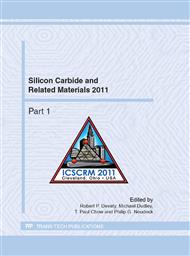[1]
J. Zhang, L. Storasta, J. P. Bergman, N. T. Son, and E. Janzén, Electrically active defects in n-type 4H-silicon carbide grown in a vertical hot-wall reactor, J. Appl. Phys. 93 (2003) 4708.
DOI: 10.1063/1.1543240
Google Scholar
[2]
P. B. Klein, B. V. Shanabrook, S. W. Huh, A. Y. Polyakov, M. Skowronski, J. J. Sumakeris, and M. J. O'Loughlin, Lifetime-limiting defects in n- 4H-SiC epilayers, Appl. Phys. Lett. 88 (2006) 052110.
DOI: 10.1063/1.2170144
Google Scholar
[3]
C. W. Litton, D. Johnstone, S. Akarca-Biyikli, K. S. Ramaiah, I. Bhat, T. P. Chow, J. K. Kim, and E. F. Schubert, Effect of C/Si ratio on deep levels in epitaxial 4H-SiC, Appl. Phys. Lett. 88 (2006) 121914.
DOI: 10.1063/1.2161388
Google Scholar
[4]
K. Danno, T. Hori, and T. Kimoto, Impacts of growth parameters on deep levels in n-type 4H-SiC, J. Appl. Phys. 101 (2007) 053709.
DOI: 10.1063/1.2437666
Google Scholar
[5]
L. Storasta and H. Tsuchida, Reduction of traps and improvement of carrier lifetime in 4H-SiC epilayers by ion implantation, Appl. Phys. Lett. 90 (2007) 062116.
DOI: 10.1063/1.2472530
Google Scholar
[6]
T. Hiyoshi and T. Kimoto, Elimination of the major deep levels in n- and p-type 4H-SiC by two-step thermal treatment, Appl. Phys. Express 2 (2009) 091101.
DOI: 10.1143/apex.2.091101
Google Scholar
[7]
L. Storasta, J. P. Bergman, E. Janzén, A. Henry, and J. Lu, Deep levels created by low energy electron irradiation in 4H-SiC, J. Appl. Phys. 96 (2004) 4909.
DOI: 10.1063/1.1778819
Google Scholar
[8]
T. Miyazawa and H. Tsuchida, Evaluation of long carrier lifetimes in thick 4H silicon carbide epitaxial layers, Appl. Phys. Lett. 97 (2010) 202106.
DOI: 10.1063/1.3517487
Google Scholar
[9]
T. Kimoto, T. Hiyoshi, T. Hayashi, and J. Suda, Impacts of recombination at the surface and in the substrate on carrier lifetimes of n-type 4H-SiC epilayers, J. Appl. Phys. 108 (2010) 083721.
DOI: 10.1063/1.3498818
Google Scholar
[10]
M. Ito, L. Storasta, and H. Tsuchida, Development of 4H-SiC epitaxial growth technique achieving high growth rate and large-area uniformity, Appl. Phys. Express 1 (2008) 015001.
DOI: 10.1143/apex.1.015001
Google Scholar


